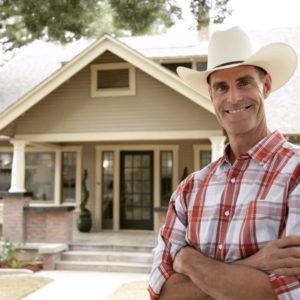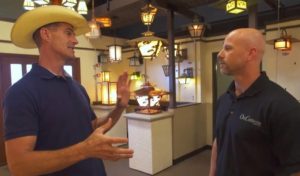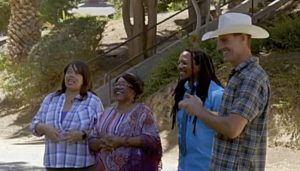Small Home Gazette, Winter 2022
Restored
A California Cowboy Returns Vintage Homes to Their Roots
Looking for some digital comfort food to consume during long winter evenings? Check out a show recommended to us by Bungalow Club member Brad Guilbeault, called Restored. It is an online series about reviving vintage homes, available for streaming at Discovery+ (discoveryplus.com).
 The heart and soul of Restored is its host, Brett Waterman. Waterman cuts a striking figure. He is well over six feet tall; is seldom seen without his cowboy hat; and is so square-jawed he looks almost cartoonish. He is also quite gregarious, with a California surfer dude vibe and an infectious laugh.
The heart and soul of Restored is its host, Brett Waterman. Waterman cuts a striking figure. He is well over six feet tall; is seldom seen without his cowboy hat; and is so square-jawed he looks almost cartoonish. He is also quite gregarious, with a California surfer dude vibe and an infectious laugh.
But behind the personality is a passionate preservationist. Waterman begins each episode with this mantra: “I’m Brett Waterman. Preservation is my passion. I love saving historic homes. It’s my job to return homes to the way they were intended to be and re-ignite pride of ownership.”
The episodes, of which there are about 40, are spread over five seasons. Each episode introduces a nice couple with a house that needs help. Waterman pays a visit and gets a tour of the home’s faults, virtually all of them the result of previous owners’ poor decisions. The current owners are then sent away and Waterman, aided by a rotating cast of contractors and craftspeople, undo the blunders. Unexpected hitches and discoveries add a dash of drama. The owners are brought back for the big reveal.
All this is edited to a brisk 40 minutes per episode, assuming you have the ad-free version of Discovery+.
Other HGTV-type shows may give a passing nod to a home’s history, but their main point is to apply a trendy, modern makeover. Several elements set Restored apart. Primary is that the house is returned, more or less, to its original state.
“Most people think of renovation as updating a house,” Waterman says in one episode. “But that’s not what I do. I restore a home to how it wants to be lived in.”
Another strength of the series is that Waterman really knows his stuff. He has a solid grasp of architectural styles; he refers to house parts by their correct names; and he has an unerring eye when it comes to spotting and reviving hidden, missing or altered components. In one episode he even reveals and restores the original kitchen floor linoleum in a 1913 home.
That said, Waterman is not interested in creating time-frozen museum houses and is not afraid to move an original wall or doorway if it will improve the home’s livability. Reworked kitchens, for example, are given vintage details but are updated for modern living.

Waterman discusses ideas for a dining room chandelier with a craftsman from Old California lighting shop.
In other makeover shows, the hosts introduce new products (aka advertising dollars) to the project. Waterman instead makes trips to architectural salvage businesses to replace missing house parts.
“People throw out incredible details all the time,” rants Waterman. “It drives me crazy! Thank goodness there’s architectural stores out there, because that’s where I get all the good stuff to restore my houses.”
He calls in restorers to bring vintage ovens back to life. He engages small-business craftspeople to create one-of-a-kind fixtures and house parts. He rips tacky facades away from fireplaces to reveal original tile and brick. He visits antiques stores so he can dress rooms with vintage furniture pieces.
Explains Waterman, “It’s not supposed to look brand new. It’s supposed to look beautifully maintained.”
Episodes of Restored cover a range of architectural styles, from Victorian to Mid-Century Modern. But a significant number feature bungalows and larger Arts & Crafts houses, as well as related styles like Tudor and Spanish colonial. Project budgets range from about $50,000 to more than $200,000. Note that all of the houses are located in southern California, so there are differences in design and construction details compared to Minnesota homes.
And it is good to keep in mind that like all home improvement shows, Restored makes everything look far easier than it actually is. Waterman appears to have access to an army of skilled construction workers, master carpenters, artists, designers, landscapers and craftspeople, all available at the drop of his cowboy hat. The rest of us can only dream of such luxury. The show’s restorations take several weeks to several months to complete, which is realistic. But oddly, the owners seem to disappear for the duration and do not have to live with the disruption and mess. Upon completion, they reappear for the big reveal. Where do they go?
On balance, though, I find the show entertaining and gratifying. There are not many home renovation shows I can get through without wincing and cringing along the way. Restored offers the vicarious thrill of watching beautiful vintage homes return to their former glory with minimal compromises.
Restored is available at discoveryplus.com. A subscription that includes commercials is $4.99 per month; a commercial-free option is $6.99 per month.
Additional Restorations
Looking for something more modest and close to home? Take a look at this episode of Down to the Studs: “1920s Bizarre Bungalow”, in which a Minneapolis bungalow goes from awful to artful. Guthrie Theater actor and handyman Bill McCallum chose to undo a 1960s house-dividing remodel (apartment in the basement). He teamed up with interior designer Amy Matthews, and together they brought back much of the bungalow’s character, while adding some modern materials that blend in pretty well.













